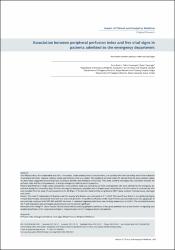Association between peripheral perfusion index and five vital signs in patients admitted to the emergency department Association between perfusion index and vital signs
Abstract
Aim: Mental status, skin temperature and color, urine output, mean arterial pressure, lactate levels, and capillary refill time are widely used in the evaluation of peripheral perfusion. However, reliable, simple, and objective tests are needed. The peripheral perfusion index (Pt), derived from the pulse oximeter signal, has been lately suggested for providing fast, continuous, bedside, and affordable clinical data. This study aimed to investigate the association between the perfusion index and five vital parameters in a large emergency medicine patient population.
Material and Methods: A single-center, prospective, cross-sectional study was carried out on 2330 adult patients who were admitted to the emergency department during five consecutive days. Patients who required emergency operation and cardiopulmonary resuscitation, and were unable to communicate with were excluded from the study. PI was measured at the 4th finger of the non-dominant hand by using Masimo RDS-7 puke oximeter. Simultaneously, vital signs were taken.
Results: The mean PI, independent of diagnosis and the severity of a disease, was calculated as 3.71 +/- 2,83. The mean PI was found to be significantly higher in males than females, respectively 4,03 +/- 3,04 and 3,36 +/- 2,56 (p<0.001). A significant difference in the mean PI levels was detected across four age groups. PI was positively correlated with SBP, DBP, and MAR Moreover, it correlated negatively with heart rate and body temperature (p<0,001). The correlation between the PI and respiratory rate and oxygen saturation was not statistically significant.
Discussion: Even though PI cannot replace clinical assessment in assessing peripheral perfusion, it has great potential to be a useful toot in recognizing poor peripheral perfusion at the triage level and lead to improved outcomes of emergency department patients.


















